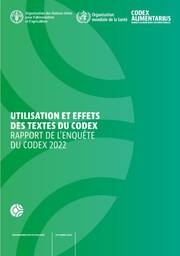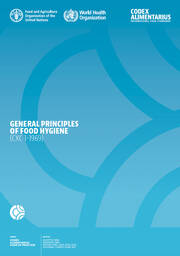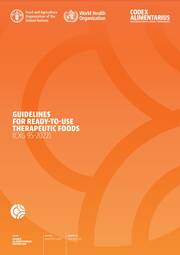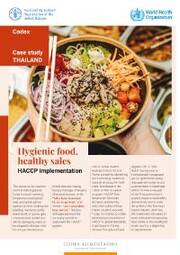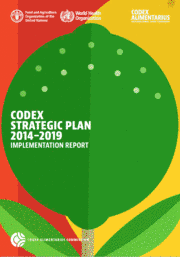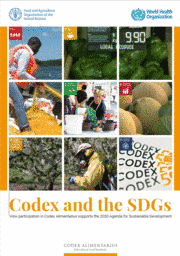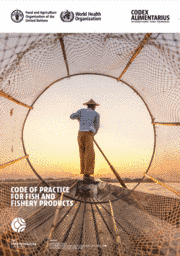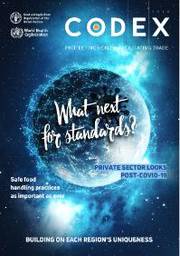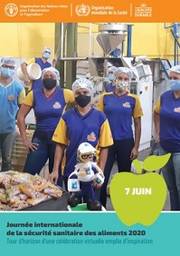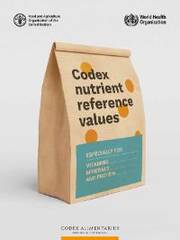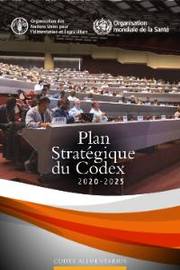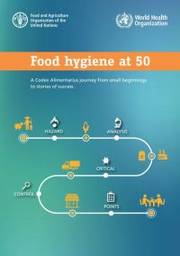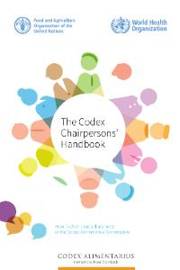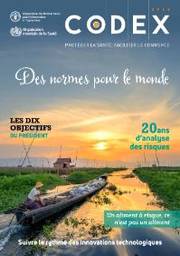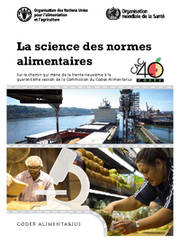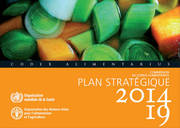Principales publications
The Codex Alimentarius Commission marks its 60th anniversary in 2023. This seventh edition of the CODEX magazine looks back at origins and looks forward to what the future may bring for the international food standard setting. Those involved in Codex, whether they be current or former Commission Chairs, Secretaries, Members or Observers, experts or host secretariats, have contributed to this celebration of Codex achievements. This publication also summarizes the work of the technical and regional committees that have met since the 45th Commission in 2022, bringing new, amended and revised texts for adoption in November 2023. It captures six decades and a year in the life of the Commission and the Codex Secretariat – working to protect health and facilitate trade.
Year: 2023 - Language: English
Le Secrétariat du Codex réalise une enquête annuelle auprès de tous les membres du Codex afin de mesurer l’utilisation et les effets des textes du Codex. Mandaté pour suivre cette question dans le cadre du Plan stratégique du Codex 2020-2025, le Secrétariat collabore depuis 2021 avec les bureaux de l’évaluation de la FAO et de l’OMS en vue d’élaborer un mécanisme permettant d’explorer diverses problématiques, telles que l’accessibilité, la pertinence et la crédibilité des normes du Codex. Dans cet objectif, l’enquête 2022 a servi de pilote.
Le rapport de l’enquête 2022 sur le Codex présente les résultats de la première enquête pilote sur l’utilisation et les effets des textes du Codex. L’enquête s'est centrée sur les textes du Codex suivants: Norme générale pour les contaminants et les toxines présents dans les produits de consommation humaine et animale, Principes généraux d’hygiène alimentaire, Norme générale pour l’étiquetage des denrées alimentaires préemballées et Principes généraux régissant l’adjonction d’éléments nutritifs essentiels aux aliments.
Elle fournit des informations sur la portée, la pertinence, la reconnaissance et l’utilisation des textes du Codex, et en fin de compte, sur leurs effets. Le rapport met en lumière les obstacles à l’adoption des textes du Codex par les membres et propose un ensemble de recommandations.
Year: 2023 - Également disponible en: Anglais, Français, Espagnol, Chinois, Russe.
This code of practice has been published in the new format with refreshed design and a DOI (digital object identifier) to monitor downloads and citations.
The General Principles of Food Hygiene is the fundamental Codex document describing the necessary food hygiene measures and food safety controls.
This new revision sees information on the hazard analysis and critical control point (HACCP) system move from an annex into the main body of the document. The update also includes modern concepts not addressed in older versions, including the role of Good Hygiene Practices (GHPs) that require additional attention because they have a greater impact on food safety.
Year: 2023 - Language: English
La résistance aux antimicrobiens (RAM) représente une sérieuse menace sanitaire à l’échelle mondiale ainsi qu’une problématique de premier ordre en matière de sécurité sanitaire des aliments. Les gouvernements et les organisations internationales reconnaissent que la question doit être abordée de façon transversale et intégrer la santé animale, la santé végétale, la santé humaine et l’environnement, conformément à l’approche «Une seule santé».
Cette publication regroupe trois textes du Codex, deux directives et un code d’usages qui aideront les gouvernements à concevoir et à mettre en œuvre une stratégie efficace contre la résistance aux antimicrobiens d’origine alimentaire.
Year: 2023 - Également disponible en: Anglais, Espagnol, Russe.
This report describes initiatives that were organized by countries in the region for World Food Safety Day in 2022. With over 20 colourful examples from Europe and Central Asia Region, the report also served as a motivator for WFSD in 2023.
Year: 2023 - Language: English
This code of practice has been published in the new format with refreshed design and a DOI (digital object identifier) to monitor downloads and citations.
Cadmium is a heavy metal that predominantly enters the environment through anthropogenic activities such as processing ores, burning fuels, contamination with industrial waste, livestock manure, and use of phosphate fertilizers.
This code of practice provides guidance on recommended practices to prevent and reduce cadmium contamination in cocoa beans before planting, for new or existing cocoa tree plantations and during the production stage through the harvest and post-harvest phases.
Year: 2023 - Language: English
This guideline is another new-look Codex text, which all now include a refreshed design and a DOI (digital object identifier) to monitor downloads and citations.
This publication provides guidance on technical and nutritional aspects of the production of ready-to-use therapeutic foods (RUTF). The provisions of these guidelines apply to RUTF for children aged from 6 to 59 months with severe acute malnutrition (SAM) who need efficacious and timely intervention including safe, palatable foods with a high-energy content and adequate amounts of vitamins, minerals and other nutrients within an appropriately designed programme that promotes continuation of breastfeeding, appropriate transition to nutritious family food and psycho-social support for recovery.
Year: 2023 - Language: English
The CODEX magazine reviews a year in the life of the international food safety standard setting body the Codex Alimentarius Commission. With testimony from the experts who attend technical meetings to set standards and the countries that host those committees, CODEX in 2022 tells the story of another year where operations have been virtual.
Contributions from the parent organizations FAO and WHO combine with insight from Observer organizations and those who operate from within the Codex Secretariat to ensure that once again the Commission will be adopting over 20 new texts this year to ensure food is safe and can be traded fairly.
Year: 2022 - Language: English
This code of practice is a pilot for the update of all Codex texts planned for 2023. New features include a refreshed design and a DOI (digital object identifier) to monitor downloads and citations of Codex texts.
Lead exposure can occur through food and water and lead contamination of food arises from numerous sources, including air, soil and water as well as from food processing, food handling, and food packaging. This code of practice indicates good agricultural and manufacturing practices to minimize lead contamination of foods.
Year: 2022 - Language: English
This case study demonstrates the impact that adoption of science-based food standards can have. When the Thai government adopted into law the Codex General Principles of Food Hygiene (CXC 1-1969), which includes guidelines on the application of the Hygiene Analysis and Critical Control Points system (HACCP) as one of its annexes, it made HACCP non-mandatory, but highly recommended. With support from FAO, the government ensured HACCP training across private companies – especially small businesses, government departments and academia.
Now, after 25 years of work promoting HACCP, the country is reaping the rewards in improved food safety at home and robust and competitive food exports.
Year: 2022 - Language: English
This issue of CODEX tells the story, committee by committee, of the commitment by global experts, host governments and the Codex family of Members and Observer organizations to ensure that the 44th Codex Alimentarius Commission would take place and have over 30 texts to adopt, protecting health and facilitating trade.
In a year of virtual reality it has been the ground-breaking work of all those involved to take meetings online that has ensured continuity throughout the pandemic.
Year: 2021 - Language: English
In 2013 the Codex Alimentarius Commission (CAC) approved its most ambitious plan to date: the Codex Strategic Plan 2014-2019. Structured around four goals, the plan aimed to guide Codex work towards more effective communication and efficient practices that would promote robust, inclusive, transparent and collaborative food standards setting.
This implementation report examines the achievements of the Strategic Plan 2014-2019. It is divided into sections that focus on the plan’s four goals and provides a summary of successes achieved and identifies the challenges that arose.
Year: 2021 - Language: English
The Codex Trust Fund (CTF) supports developing and transition economy countries to participate fully and effectively in Codex.
Exploring 12 country and one group project from around the globe, this publication tells the story of each country’s achievements and successes, as well as the challenges they faced in designing, planning and delivering projects under the Trust Fund.
It also serves as a valuable resource, rich with lessons learned for those countries currently embarking on CTF projects or planning to do so in the future.
Year: 2020 - Language: English
This publication developed by the Codex Trust Fund in collaboration with the Codex Secretariat describes how participation in Codex Alimentarius supports the 2030 Agenda for Sustainable Development
With stories and reports focussing on six SDGs in different countries, readers learn how Codex work supports countries to achieve these particular development goals, which are interconnected with other SDGs and the 2030 Agenda generally.
Codex and the SDGs also highlights how the Codex Trust Fund supports developing and transition economy countries to build food safety capacity, which helps equip them to pursue the SDGs more successfully.
Year: 2020 - Language: English
This updated version of the Code of Practice for Fish and Fishery Products delivers key technical guidance on the harvesting, processing, transport and sale of fish and fishery products and is an essential reference point for both small and large-scale operators.
New guidance developed in the Codex Committee on Food Hygiene is now included in the code, introducing valuable additional information and technical direction on how to minimize the risk of histamine build-up in fish and fishery products at key steps in the food chain from harvesting to processing.
Year: 2020 - Languages: Arabic, Chinese, English, French, Russian and Spanish
Each year this annual report, in a captivating magazine format, records the work of the Codex Alimentarius from one Commission to the next.
Before the COVID-19 pandemic brought a halt to international travel and physical meetings in March 2020, some of the technical committees and all six FAO/WHO Coordinating Committees did meet as planned.
With a special focus on the Codex regions including contributions from Member Countries, the Codex parent organizations and some of the global experts who work with Codex, this 4th edition of the magazine reports on local, regional and global issues effecting food safety and fair practices in food trade.
Year: 2020 - Languages: Arabic, Chinese, English, French, Russian and Spanish
La deuxième Journée internationale de la sécurité sanitaire des aliments des Nations Unies a eu lieu en plein cœur d’une période exceptionnelle due à la pandémie mondiale de COVID-19. Pendant toute une journée, voire une ou plusieurs semaines, les «masques, microbes et microphones» ont obligé à réorganiser les initiatives mises en place par les particuliers, les familles, les communautés, les écoles, les entreprises et les autorités publiques afin de s’adapter à une «nouvelle norme» qui aura sans doute un impact important sur la sécurité sanitaire des aliments et les systèmes alimentaires dans un proche avenir. Ce tour d’horizon des manifestations organisées dans le monde n’est qu’un aperçu des séminaires en ligne, vidéos, conférences de presse, éditoriaux, concours, publications sur les réseaux sociaux, messages de campagne et autres événements auxquels ont contribué des millions de personnes à travers le monde en mai et juin 2020.
Année: 2020 - Langues: anglais, français, espagnol, arabe, chinois et russe
This publication explains how Codex and the Committee for Nutrition and Foods for Special Dietary Uses worked over several years to develop the Codex nutrient reference values for protein, 13 vitamins and 6 minerals in the Codex guidelines for nutrition labelling. Nutrient reference values (NRVs) are a set of values used in nutrition labelling derived from authoritative recommendations for daily nutrient intake.
Drawing from primary evidence from several countries, the publication will play a role in informing the general population about healthy eating for the next 10-20 years and forms the basis for establishing a suite of required NRVs for more specific population groups, the first of which are older infants and young children.
Year: 2019 - Language: English
Le Plan stratégique 2020-2025 présente la mission, la vision, les buts, les objectifs et les indicateurs mesurables de la Commission.
Ill sous-tend la haute priorité qui continue d’être accordée par la FAO et l’OMS à la sécurité sanitaire et à la qualité des aliments et donne des indications à la Commission pour qu’elle mène à bien ses responsabilités et son mandat, qui consiste à protéger la santé des consommateurs et à veiller à la loyauté des pratiques dans le commerce des aliments.
Le Plan stratégique informe les membres, les organisations intergouvernementales et les organisations non gouvernementales internationales et d’autres intervenants de la façon dont la Commission entend s’acquitter de son mandat et satisfaire, sur la période 2020-2025, les besoins et les attentes de ses membres, notamment en ce qui concerne les problèmes naissants.
Année de publication: 2019 - Disponible en: Anglais, Français, Espagnol, Russe et Chinois
2019 has been the year of food safety with The First FAO / WHO / AU International Food Safety Conference in Addis Ababa and the WTO International Forum on Food Safety and Trade in Geneva shining the global spotlight on issues that will affect global food production and supply systems, consumers, industry and the planet itself. The Codex Alimentarius Commission is where the world comes together to set international food safety and quality standards to protect consumer helath and facilitate intenrational trade.
This publication reports on the Codex year and is produced in conjunction with the 42nd Codex Alimentarius Commission held in Geneva 8-12 July 2019.
Year: 2019 - Language: English
Matters of food authenticity are less likely to create problems for public health but they can and do create great damage in the market, leading to breakdowns in consumer confidence and unfair competition as honest traders are unable to match the discounted prices of their fraudulent rivals.
The Codex Committee on Fats and Oils (CCFO) was established in 1964 to elaborate worldwide standards for fats and oils of animal, vegetable and marine origin including margarine and olive oil.
This publication explores how CCFO operates and the role Malaysia has played since taking over the committee from the UK in 2009. With contributions from producing nations, traders, members and observers, the reader will glimpse what goes on in an international standard setting body to ensure safe food and a level playing field for trade.
Year: 2019 - Language: English
In 1964, nine Codex Alimentarius Commission Member countries and a number of Observer organizations gathered in Washington DC, United States of America to begin building consensus on how to produce food hygienically and, where feasible, set limits for microbial counts in foods. Thanks to the visionary approach of Codex in those early years, knowledge about how to safely prepare and handle food was used to develop standards, providing tools for both national regulatory authorities and the food industry to systematically improve food hygiene. The leaps and bounds made over five decades mean that food can now be safely produced, processed and distributed in greater volumes and over greater distances than ever before.
Year: 2019 - Language: English, French, Spanish
The Handbook provides guidance to national officials nominated to serve as chairpersons of subsidiary bodies of the Codex Alimentarius Commission — grouping together in one handy place a range of institutional memory, good practices, rules and useful tools for use as a reference by chairpersons as they prepare for and discharge their duties. The number of committees in the Codex system and the way in which they are chaired had demonstrated the need for such an information product. In the form of a Handbook, it serves as a legacy publication, enshrining as a single resource more than a decade of practical knowledge and experience of senior Secretariat officials and the community of experienced Codex chairpersons.
The Handbook will contribute to: ensuring the effective and equitable participation of Member State officials in Codex work (capacity-development); enhancing communication with stakeholders (communication); and promoting transparency, neutrality and an open, rules-based approach in the conduct of Codex work.
The Handbook is structured to serve as a direct and useful guide for its primary community of users — Codex committee chairpersons — and works hand-in-hand with other resources, guiding chairpersons to participate and build a living community of practice through multiple online resources, such as the Codex Online Commenting System and Codex Chairpersons’ Platform.
Year: 2018 - Language: English
Depuis plus de cinquante ans, les textes du Codex contribuent dans une très large mesure à la sécurité sanitaire et à la qualité de notre alimentation. Le Codex Alimentarius constitue un ensemble de règles générales que tous les acteurs de la filière alimentaire peuvent suivre. C'est en même temps une référence fondamentale pour les pays qui renforcent leur système national de contrôle de la sécurité sanitaire des aliments.
La cinquième édition de la brochure «Comprendre le Codex» permettra aux lecteurs de se faire une idée plus précise de ce qu'est la Commission du Codex Alimentarius, de son fonctionnement et des résultats qu'elle a obtenus. Les personnes intéressées pourront ainsi rapidement saisir la structure du système du Codex, avoir un aperçu des comités techniques spécialisés et obtenir des détails sur les procédures et processus suivis.
Année: 2018 - Langue: français
Au cours de l’année, les comités du Codex se réunissent pour débattre de la mise à jour des normes alimentaires, directives et codes d’usages internationaux. L’organe directeur du “code alimentaire”, connu sous le nom de Commission du Codex Alimentarius (CAC), prend des décisions sur les propositions des comités, lors de sa réunion annuelle en juillet.
À travers une série d’articles de style magazine, le “Codex” partage les points de vue et les contributions des nombreux partenaires qui incluent 188 pays membres et l’Union européenne ainsi que 200 observateurs.
Année: 2018 - Langue: français
Dans un nouveau rapport intitulé Trade and Food Standards (commerce et normes alimentaires), l'Organisation des Nations Unies pour l'alimentation et l'agriculture (FAO) et l'Organisation mondiale du commerce (OMC) expliquent de façon concise le processus de définition et de mise en application des normes alimentaires internationales. L'harmonisation des normes vise à protéger la santé publique, à réduire le fardeau de la mise en conformité qui pèse sur les producteurs et à atténuer les risques de perturbations coûteuses des échanges commerciaux.
Année: 2017 - Langue: français
La présente publication illustre les étapes parcourues par le Codex Alimentarius de juillet 2016 (trente-neuvième session de la Commission) à juillet 2017 (quarantième session de la Commission) sur la voie d'une alimentation saine et de qualité pour tous. Pendant cette période, 12 comités techniques et six comités régionaux se sont réunis afin de mettre à jour les normes alimentaires, les directives et les codes d'usages internationaux. L'organe directeur du «code alimentaire», c'est à dire la Commission du Codex Alimentarius, se prononce sur les propositions émanant des comités lors de sa réunion annuelle, qui se tient en juillet. Par une série d'articles au format magazine, cette publication recueille les points de vue et les contributions des divers partenaires, à savoir 187 États Membres et l'Union européenne, ainsi que plus de 200 observateurs.
Année: 2017 - Langue: français
La Commission du Codex Alimentarius envisage une offre alimentaire mondiale assurant au consommateur un niveau de protection le plus élevé possible, notamment en matière de sécurité sanitaire et de qualité des aliments. À cette fin, la Commission élaborera des normes et textes correspondants reconnus au niveau international, qui soient fondés sur des principes scientifiques et aient pour but de protéger la santé des consommateurs et d'instaurer des pratiques commerciales loyales, en vue de leur intégration dans les règlements nationaux et de leur application au niveau du commerce international des denrées alimentaires.
Année: 2014 - Langue: Français
Le Manuel de procédure de la Commission du Codex Alimentarius aide les délégations nationales et les organisations internationales présentes en tant qu'observateurs à participer efficacement aux travaux du Programme mixte FAO/OMS sur les normes alimentaires. Il définit les règles de procédure de base, les procédures d'élaboration des normes Codex et des textes connexes, ainsi que les définitions et directives de base pour le fonctionnement des comités du Codex. Il indique également la composition de la Commission du Codex Alimentarius.
Cette 28e édition nouvellement conçue, avec le premier changement de présentation depuis les années 1960, modifie la section sur les normes de produits traitant des conteneurs non destinés à la vente au détail ; introduit un nouveau texte sur les « Critères et directives procédurales pour les comités du Codex et les groupes de travail intergouvernementaux ad hoc travaillant par correspondance », et il existe une nouvelle annexe concernant « l'approche pour l'extrapolation des limites maximales de résidus de médicaments vétérinaires à une ou plusieurs espèces à la principes d'analyse des risques appliqués par le Comité sur les résidus de médicaments vétérinaires dans les aliments".




